The right window treatments can totally change how light flows into your home, turning plain rooms into spaces you actually want to spend time in.
Remember to repin your favorite images!
Sunlight shapes everything—from your mood to the way your favorite chair looks in the afternoon—so picking shades, blinds, or curtains really matters.
You can find that sweet spot between natural light and privacy with the huge range of window treatment options out there today.
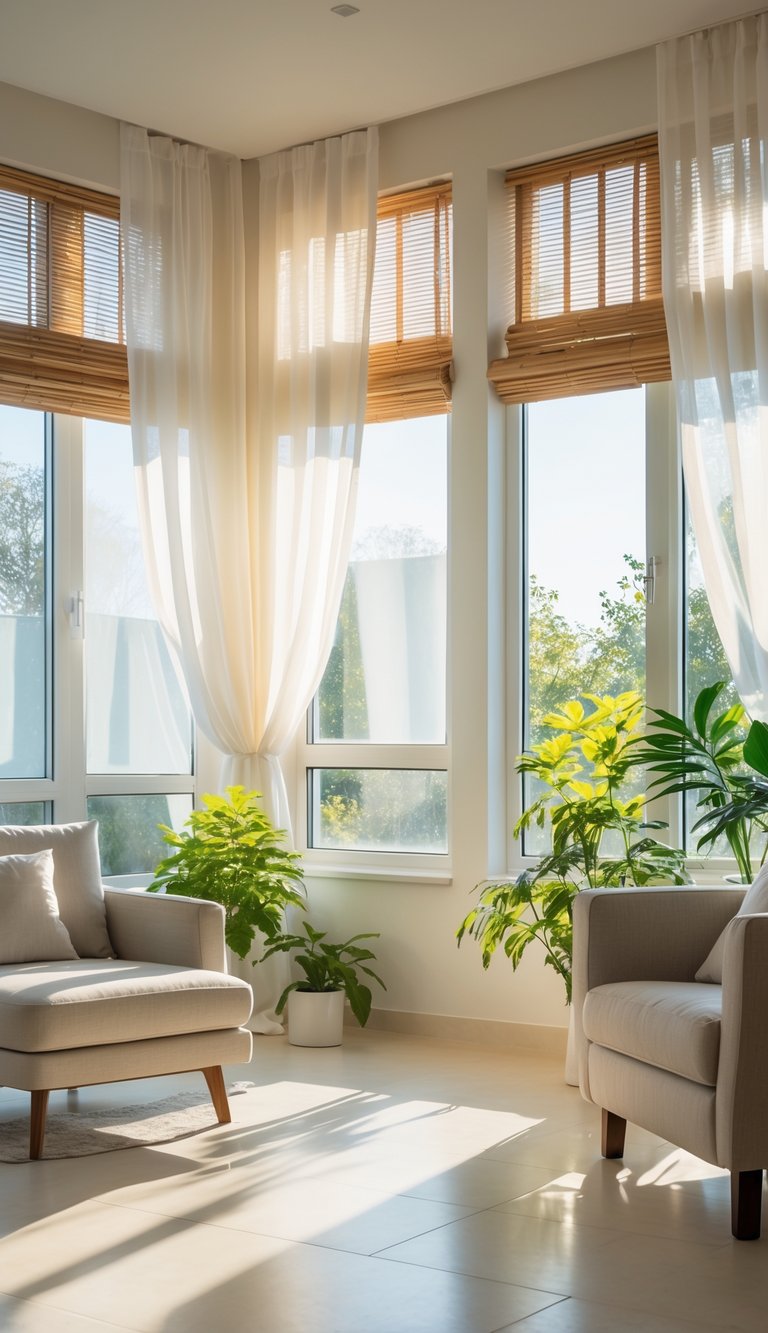
Think about what each room actually needs before choosing window treatments.
Light-filtering picks like cellular shades and sheer curtains soften strong sunlight but still make your rooms feel bright.
For bedrooms or media rooms, blackout curtains or roller shades keep out the light when you want it dark.
Some modern options, like Hunter Douglas Nantucket™ Sheer Shades, let you tweak the light all day long.
Your windows aren’t just holes in the wall—they’re chances to set the mood in your home.
A smart window treatment can cut glare on your screens, help keep things comfy, and set the vibe for whatever you’re doing.
You don’t have to pick between style and function either—there are good-looking choices at every budget.
Understanding Light Quality in Interior Spaces
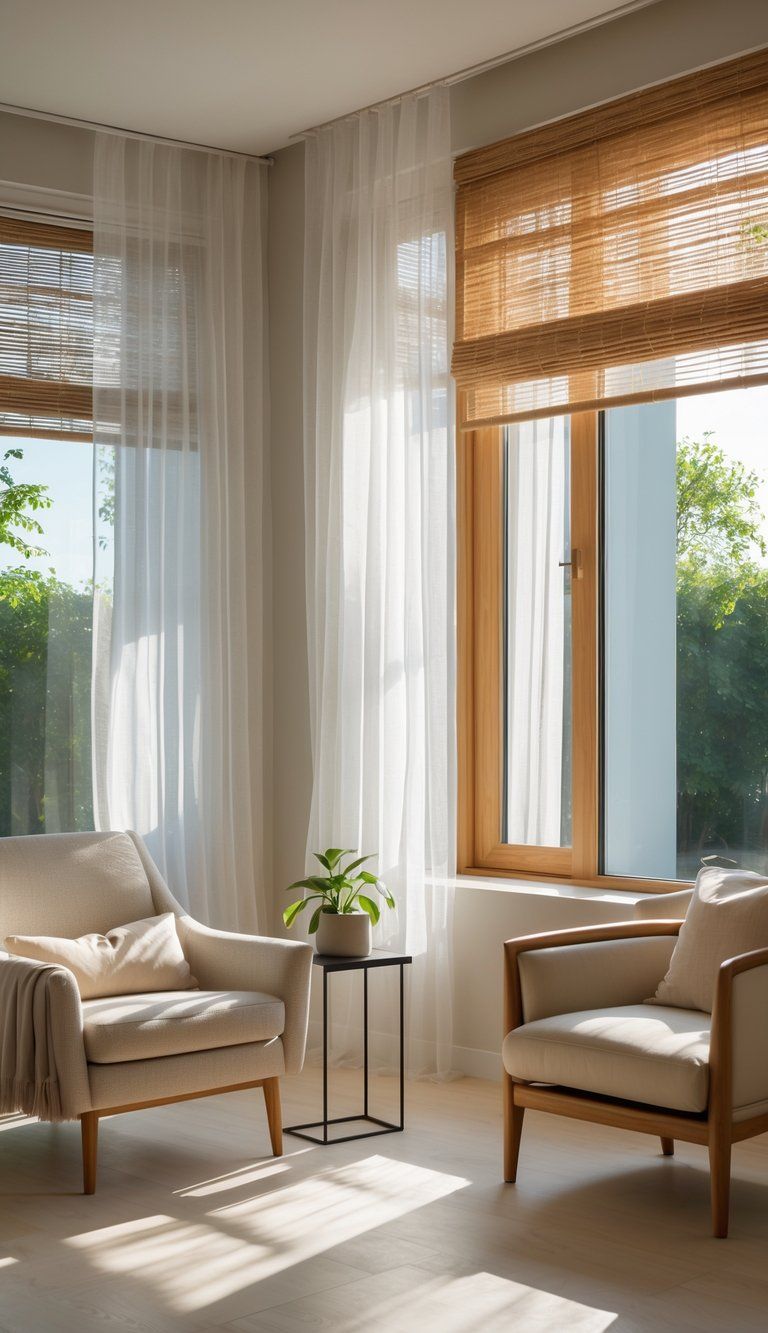
Light really changes how you feel at home.
It shapes your mood and even how you use each room at different times.
The Science of Natural Light
Natural light shifts all day, so your home never looks quite the same from morning to night.
Morning light feels cool and blue, while evening brings that golden, cozy glow.
This rhythm—your circadian clock—nudges your body and your mood along.
Sunlight gets inside three ways: direct beams, diffused through clouds or sheer curtains, and bouncing around as reflected light.
South-facing windows stay bright most of the day, while north-facing ones keep things chill and gentle, with less glare.
Light’s angle changes everything. Low sun in the morning or evening throws dramatic shadows, while midday light comes from above and flattens things out.
Lighting and Aesthetics in Home Design
Light changes the way colors look, sometimes in ways you don’t expect.
Daylight shows colors honestly, but artificial bulbs? They can make things warmer or mess with blues and greens.
Light and texture go hand in hand:
- Directional light highlights texture with shadows.
- Diffused light softens everything.
- Reflected light hides texture, making things look smoother.
Wall color reacts to light too.
Pale walls bounce light around, making rooms feel bigger and brighter.
Dark walls soak up light, making spaces feel snug and intimate.
Think about materials, too.
Glass and metal bounce light and make things sparkle.
Wood and fabric soak it up, adding warmth.
Mixing different materials gives your space a sense of depth as light plays across surfaces.
The Impact of Light on Functionality
Every room does something different, so the lighting should match the job.
Kitchens need bright, focused light so you don’t chop your finger instead of a carrot.
Living rooms work best with layers—bright for reading, softer for relaxing.
Light actually changes how you use a room as the day goes on.
East-facing rooms shine in the morning, while west-facing ones get that gorgeous evening sun.
If your lighting isn’t right, you might end up with headaches or eye strain.
Placing your lights carefully keeps glare off screens and makes reading more comfortable.
Here are the basics:
- Task lighting: for stuff like reading or cooking.
- Ambient lighting: fills the whole room.
- Accent lighting: shows off art or cool details.
Smart window treatments let you change the light as you need—turning a bright workspace into a chill retreat in seconds.
Types of Window Treatments for Enhanced Light Control
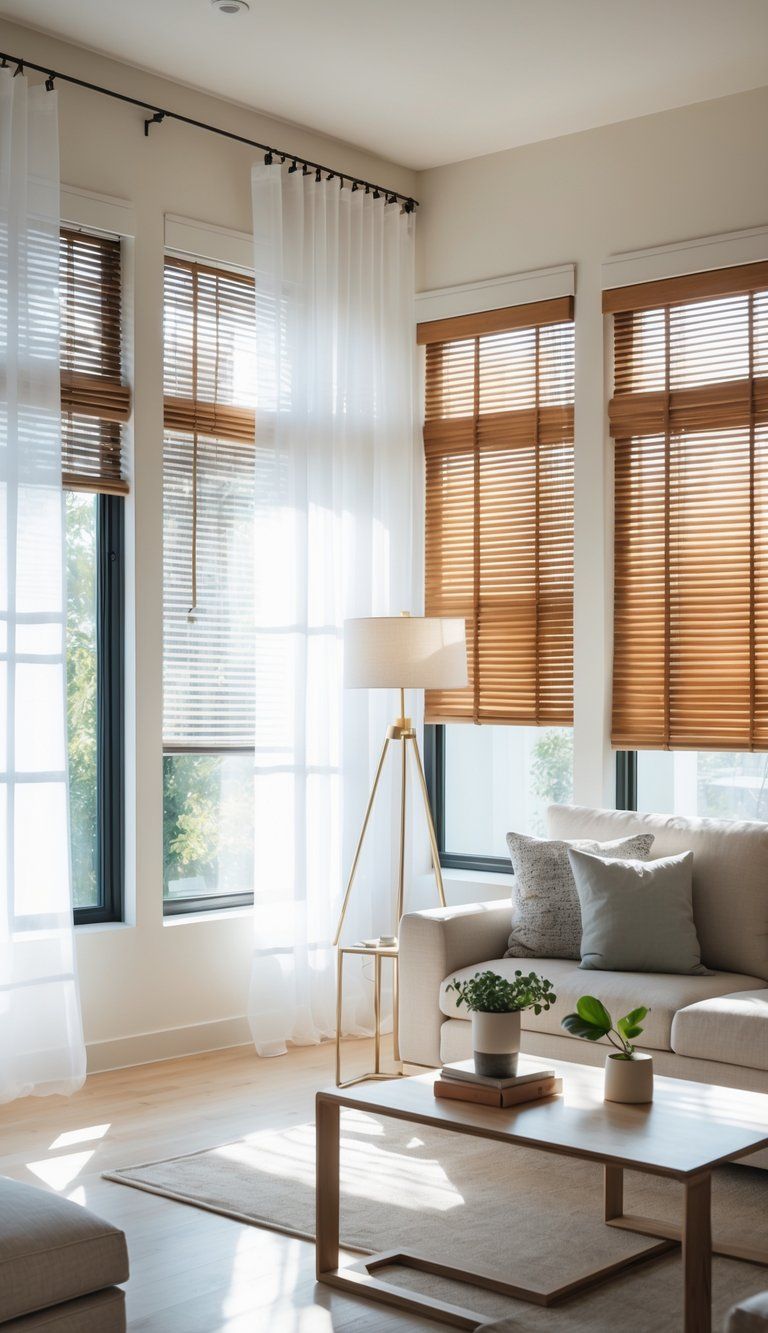
Window treatments do more than just look pretty—they’re your main tool for managing natural light.
Pick the right one, and you can totally change how a room feels.
Shades: Versatility and Style
Shades give you solid light control and a clean look.
Roller shades are simple and come in everything from sheer to blackout.
Lift them up, and they pretty much disappear so your view stays open.
Cellular (honeycomb) shades trap air in their pockets, which means you get light control and a bit of insulation.
That makes them a smart, energy-saving choice.
Roman shades bring together the practical side of shades and the soft vibe of fabric.
When you lift them, they fold up in a way that adds some nice texture.
If you want to switch up the light throughout the day, day/night shades are a solid pick.
Their dual layers let you go from sheer to private with one move.
Blinds: Precision and Flexibility
Horizontal slat blinds let you fine-tune the light more than most treatments.
You can lift or tilt them, so you’re always in control.
Wood and faux wood blinds have wider slats (usually 2-2.5 inches), letting in more light and giving you a better view when open.
They’re great for living rooms and home offices where you want sunlight but also want to keep things private.
Aluminum mini blinds use smaller slats and work well in kitchens and bathrooms.
They handle moisture and give good light control for less money.
Vertical blinds still make sense for sliding doors and big windows.
They’re easy to adjust and clean, which is nice in busy spots where you’re always tweaking the light.
Curtains: Texture and Ambiance
Curtains and drapes soften up a space and give you lots of light control options.
Sheer curtains take the edge off harsh sunlight, filling the room with a gentle glow but not blocking your view.
Medium-weight curtains hit a nice balance between letting light in and giving you privacy.
Cotton and linen blends are great for everyday spaces when you want some light but don’t want to be totally exposed.
For blocking out light, blackout curtains with special linings work best.
They’re perfect for:
- Bedrooms
- Media rooms
- Spaces with strong morning or evening sun
If you want to get fancy, layer curtains with other window treatments.
Sheer panels plus room-darkening curtains let you tweak the light as much as you want.
Selecting the Right Shades for Desired Light Quality
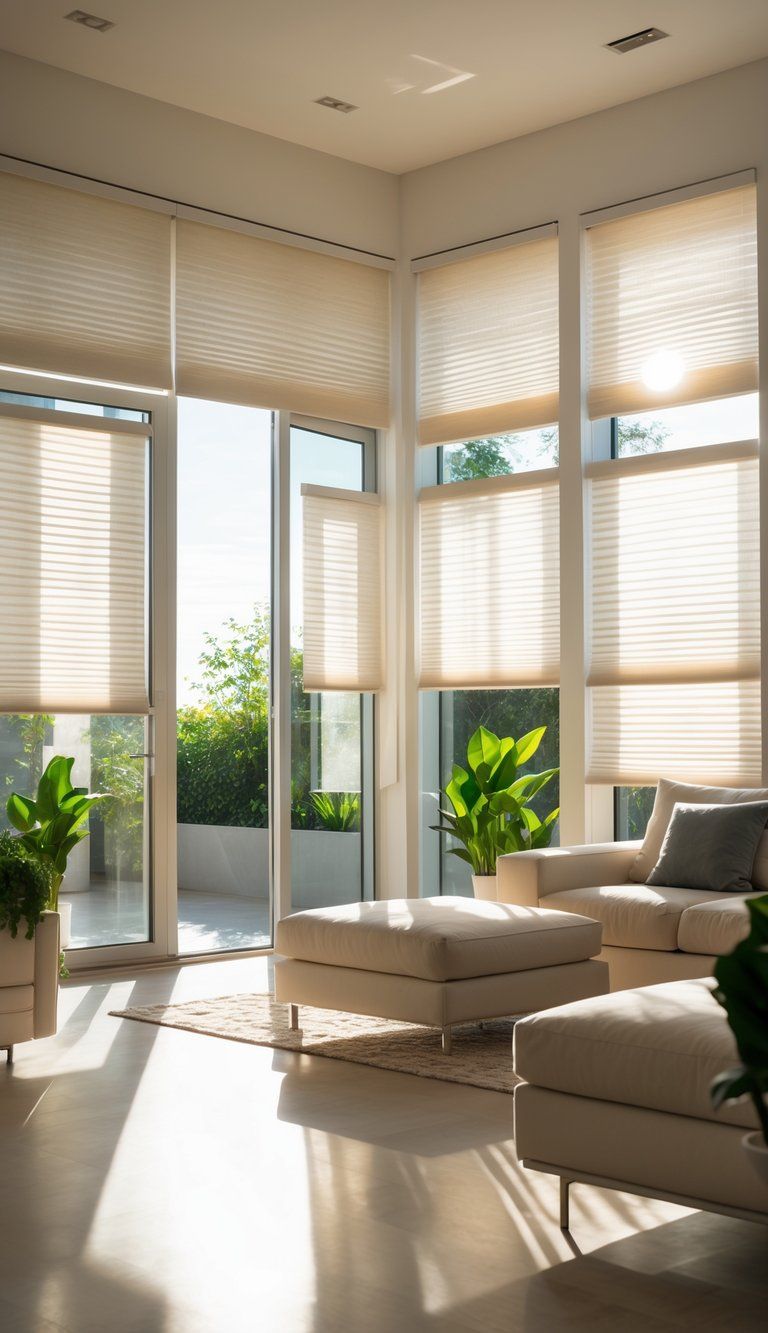
The right window shades can change how natural light fills your home and still give you the function you need.
Different shades offer different levels of light control, insulation, and style—so you’ve got options.
Cellular and Honeycomb Shades for Insulation
Cellular honeycomb shades are basically the MVPs of energy efficiency.
Their design creates little air pockets that trap heat or cold, so your home stays comfy whether it’s sweltering or freezing outside.
You can get them in single, double, or triple-cell versions.
More cells mean better insulation, but you do lose a bit of light.
Light-filtering cellular shades soften bright sunlight into a warm, cozy glow and add privacy during the day.
If you need darkness, blackout cellular shades can block almost all the light.
These shades can even lower your energy bills by up to 20%, especially if your windows aren’t the best insulated.
They’re extra useful if you live somewhere with wild weather.
Roman Shades: Combining Elegance with Utility
Roman shades strike a balance between looking good and working well.
They fold up into neat pleats, so you get a tailored vibe that fits both classic and modern rooms.
You can pick from light-filtering, room-darkening, or blackout options, so you’re in control of the light.
The fabric you choose changes everything—sheer Romans keep things soft and bright, while heavier ones add privacy and a gentle glow.
Blackout-lined Romans, though, can make a room almost pitch black.
A lot of Roman shades now have cordless designs, which is safer for kids and looks cleaner.
Some even let you open them from the top or bottom, giving you privacy below and sunlight up high.
Roller and Solar Shades for Glare Reduction
Roller and solar shades are all about keeping things simple and sleek.
They manage light and cut glare without blocking your view.
Their minimalist look fits modern homes, but honestly, they work anywhere.
Solar shades are made to filter UV rays while still letting you see outside.
You can choose the openness factor—lower numbers block more light and add more privacy.
A 3% openness solar shade, for example, blocks 97% of UV rays but you can still see out.
That’s great for rooms with screens or valuable stuff you don’t want faded by the sun.
Standard roller shades give you more privacy choices, from gently filtered light to total blackout.
Some even have reflective backs to bounce heat away, which helps keep things cool in summer.
Blinds and Shutters: Tailoring Privacy and Sunlight
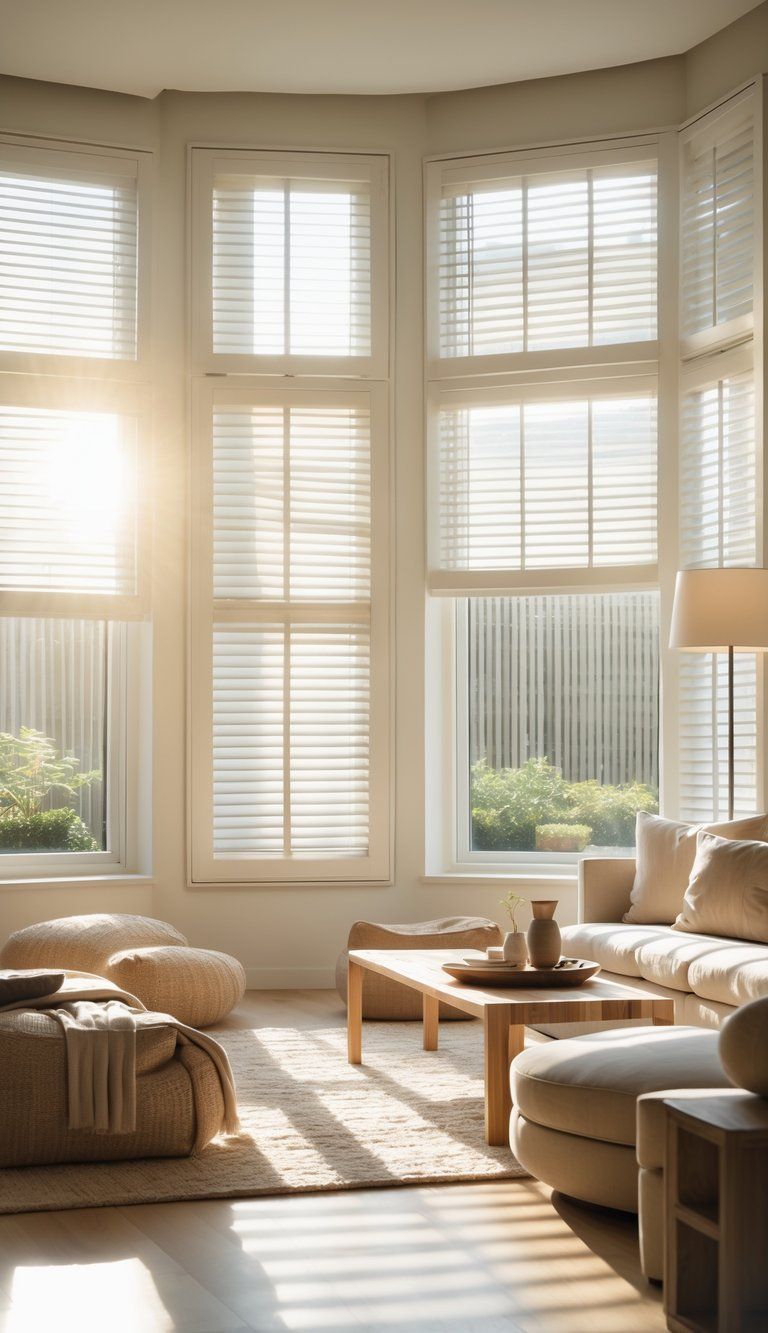
Blinds and shutters give you flexible ways to control both privacy and sunlight.
They can totally shift a room’s mood and also protect you from UV rays and prying eyes.
Wood and Faux Wood Blinds
Wood blinds add warmth and a touch of class to any space.
Manufacturers use hardwoods like basswood or oak, and you can tilt the slats to let in just the right amount of light.
These fit right into living rooms and studies, especially if you want a traditional, cozy feel.
Faux wood blinds offer the same look for less money and resist moisture better, so they’re ideal for kitchens and bathrooms.
Both come in different slat sizes—wider slats let in more light when open and keep things private when closed.
You’ll find finishes from pale oak to deep mahogany, so matching your decor isn’t hard.
For extra privacy, go for blinds with tight slat spacing and add cloth tape to cover up cord holes.
Venetian and Vertical Blinds
Venetian blinds use horizontal slats strung together with cords or tapes, so you can adjust both light and privacy easily.
They come in aluminum, vinyl, or wood, and fit windows of all shapes and sizes.
Aluminum Venetians have a slim profile, which is handy if your windows don’t have much depth.
Vertical blinds are the go-to for big windows and sliding doors.
You can adjust them for filtered light or pull them aside for a clear view.
They’re easy to clean, too—a bonus if you have pets or kids.
Privacy Tip: In bedrooms and bathrooms, pick blinds with features that block silhouettes when the lights are on.
Plantation, Reclaimed Wood, and Interior Shutters
Plantation shutters have wide louvers (usually 2-5 inches) that let you control both light and air flow.
Installers usually mount them inside the window frame, giving a built-in look that can even boost your home’s value.
Reclaimed wood shutters add character and a bit of history.
Every piece is unique, with its own grain and quirks.
Interior shutters can be custom-made for any window shape—even arches or circles.
They’re solid, so you get some insulation and noise reduction.
Unlike blinds, shutters don’t have cords dangling everywhere, which makes them safer for kids and pets.
They’re also tough—some last for decades with barely any upkeep.
Curtain and Drapery Solutions for Every Room
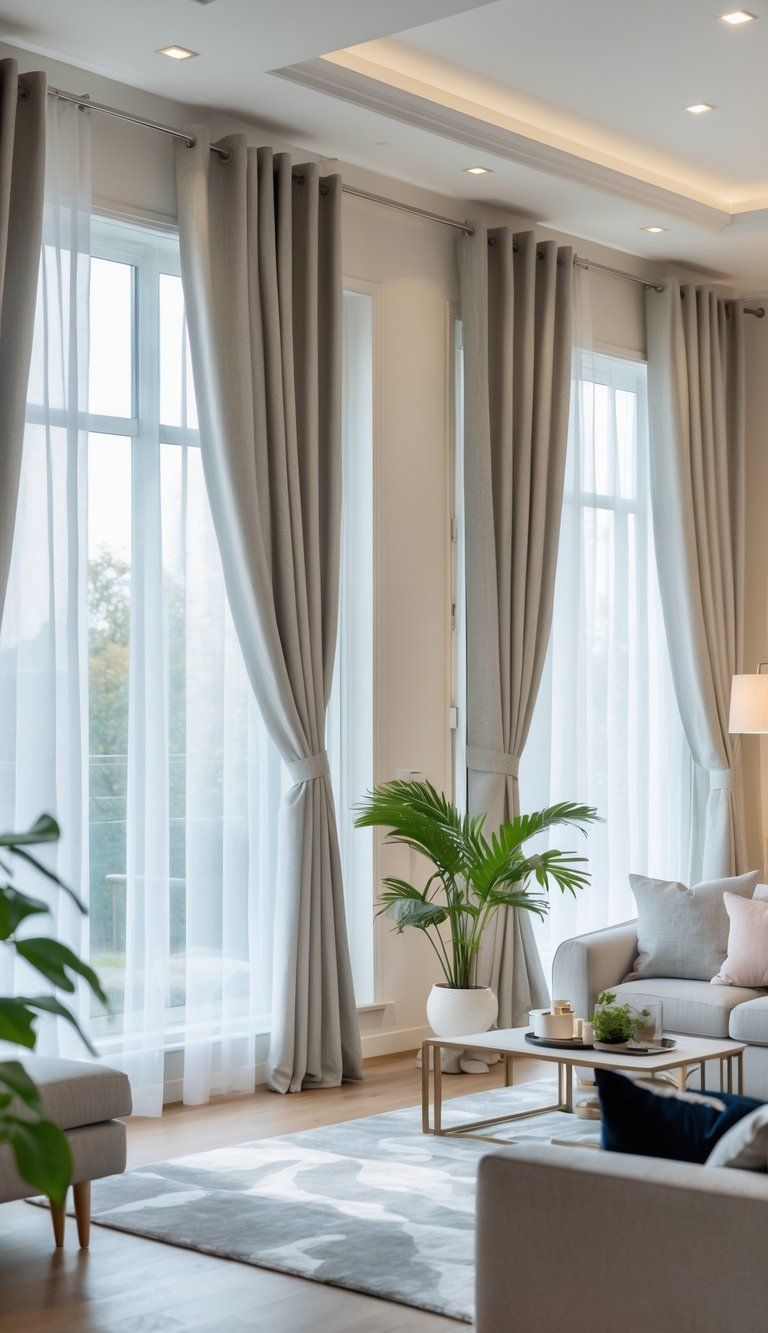
Picking the right curtains and drapes can totally change how light fills your rooms.
You can set different moods and make your home work better for you, all with a few panels of fabric.
Sheer and Blackout Curtains
Sheer curtains let sunlight in but keep things private during the day.
They’re light and airy, creating a soft glow that works well in living and dining rooms where you want natural light without the harshness.
Blackout curtains do the opposite.
They block almost all light, which is a lifesaver in bedrooms or media rooms.
Modern blackout curtains actually look good now—no more heavy, old-school drapes.
If you want the best of both worlds, hang both on the same window.
Use the sheers during the day for light and privacy, then close the blackout layer at night or when you need to block the sun.
Layered Curtain Treatments
When you layer window treatments, you get more control over light, privacy, and style. People often choose this combo:
- Blinds or shades as the base layer
- Sheer curtains in the middle
- Decorative drapes on the outside
With this setup, you can tweak how much light enters your room during the day. If you keep the sheers closed, you get soft illumination and privacy. Pull the drapes when you want things darker.
Layering also makes a room look deeper and more interesting. Pick complementary colors or mix up textures if you want a little more flair. Imagine crisp roman shades with loose linen drapes—it’s a nice contrast.
Fabric Selection and Light Diffusion
The fabric you pick really changes how light fills your space.
| Fabric Type | Light Effect | Best For |
|---|---|---|
| Linen | Soft, natural diffusion | Living areas, sunrooms |
| Velvet | Complete blockage | Bedrooms, theaters |
| Cotton | Moderate filtering | Versatile for most rooms |
| Silk | Warm, elegant glow | Formal spaces |
Heavier fabrics block more light and insulate better. Lighter fabrics let in more light, even if they’re darker colors.
Think about which way your windows face. North-facing rooms usually need light-boosting fabrics. South-facing ones? You’ll probably want something stronger to block heat and glare.
Room-by-Room Guide to Transforming Light Quality
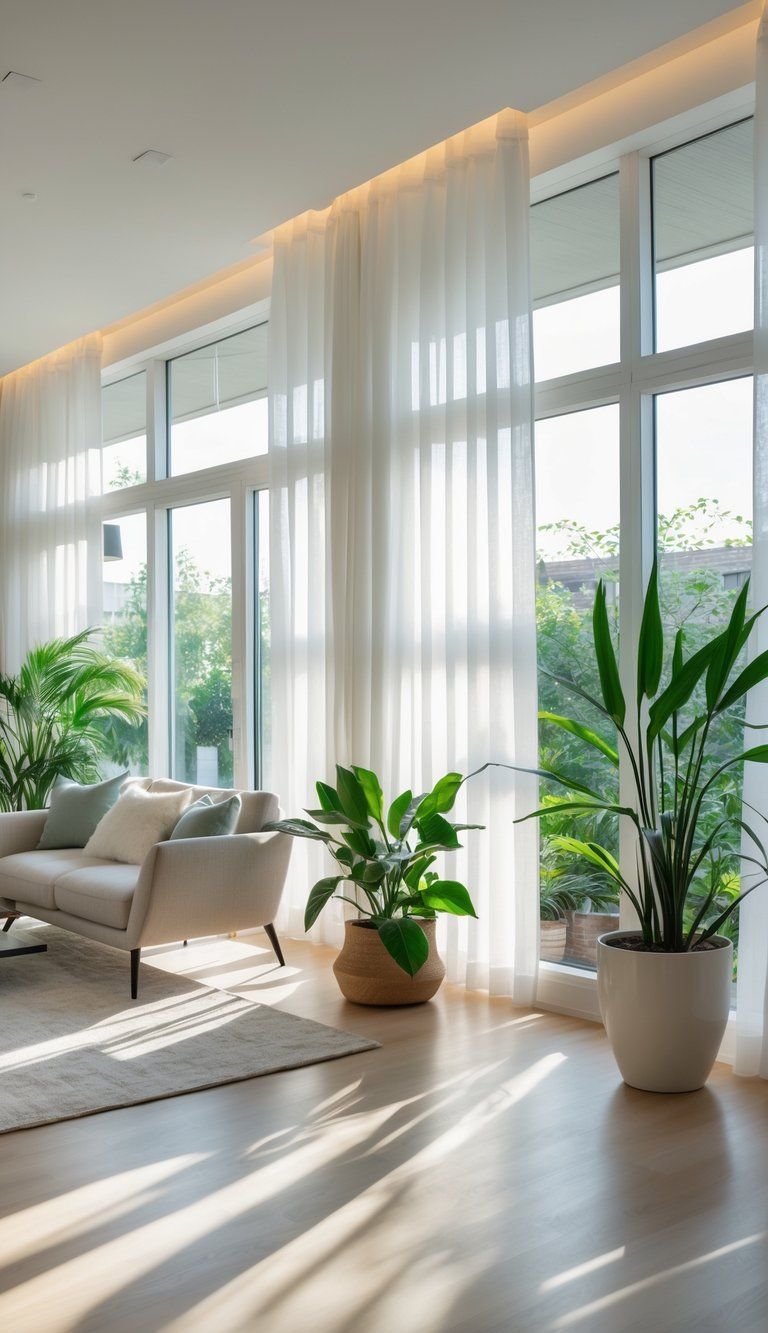
Each room in your home has its own needs for window treatments. Your lifestyle and the room’s purpose shape what works best for light, mood, and comfort.
Bedroom Solutions for Restful Sleep
Bedrooms need darkness for sleep but should also let in natural light when you want it. Blackout curtains or shades turn your room into a sleep sanctuary.
Try layering for flexibility. Start with blackout roller or cellular shades, then add decorative drapes for extra style and light control.
Motorized shades can open on a schedule, gently waking you up with sunlight. That little change can make mornings way less harsh.
If you share a bedroom, dual-panel blackout curtains let one person sleep while the other enjoys some daylight.
Light-filtering cellular shades work well in bedrooms without privacy issues but where you still want soft, diffused light.
Living Room Treatments for Social Spaces
Living rooms do best with flexible window treatments that change with your activities. Sheers and heavier drapes together give you options.
Best living room choices:
- Layered sheers and drapes
- Solar shades (2-5% openness)
- Top-down/bottom-up shades
- Plantation shutters
Solar shades cut glare on TVs but keep your view and allow some daylight. A 2-5% openness factor usually works well.
Think about which way the room faces. South-facing spaces might need stronger sun control.
Roman shades in light fabrics give a soft, cozy glow—great for chatting with friends and keeping nosy neighbors out.
Kitchen and Bathroom Considerations
Kitchens and bathrooms deal with moisture, so you need window treatments that won’t warp or stain.
Kitchen windows should give you privacy but still let in light for cooking. Café curtains cover the bottom half, so you get both.
Faux wood blinds or vinyl shutters handle humidity and clean up easily. They’re especially good above sinks where water splashes.
For bathrooms, try these moisture-resistant options:
- Vinyl roller shades
- Faux wood blinds
- Polyester roman shades
- Frosted window film
Small bathrooms look brighter with translucent roller shades. Skip heavy fabrics—they trap moisture and can get musty.
Home Office and Study Essentials
Workspaces need smart light control to keep screens glare-free and reading comfy. The right window treatment can really help you focus.
Solar shades with 1-3% openness filter out harsh light but keep your view. That’s a big win for your eyes during long work days.
Anti-glare picks for computer use include top-down/bottom-up cellular shades. Lower them from the top to block sun but keep natural light below.
Adjustable blinds can bounce light up to the ceiling, giving you soft room light without screen glare. Horizontal blinds do this well.
For video calls, try light-diffusing treatments. They spread light evenly over your face—no weird shadows or bright spots.
Energy Efficiency and Cost Savings Through Window Treatments
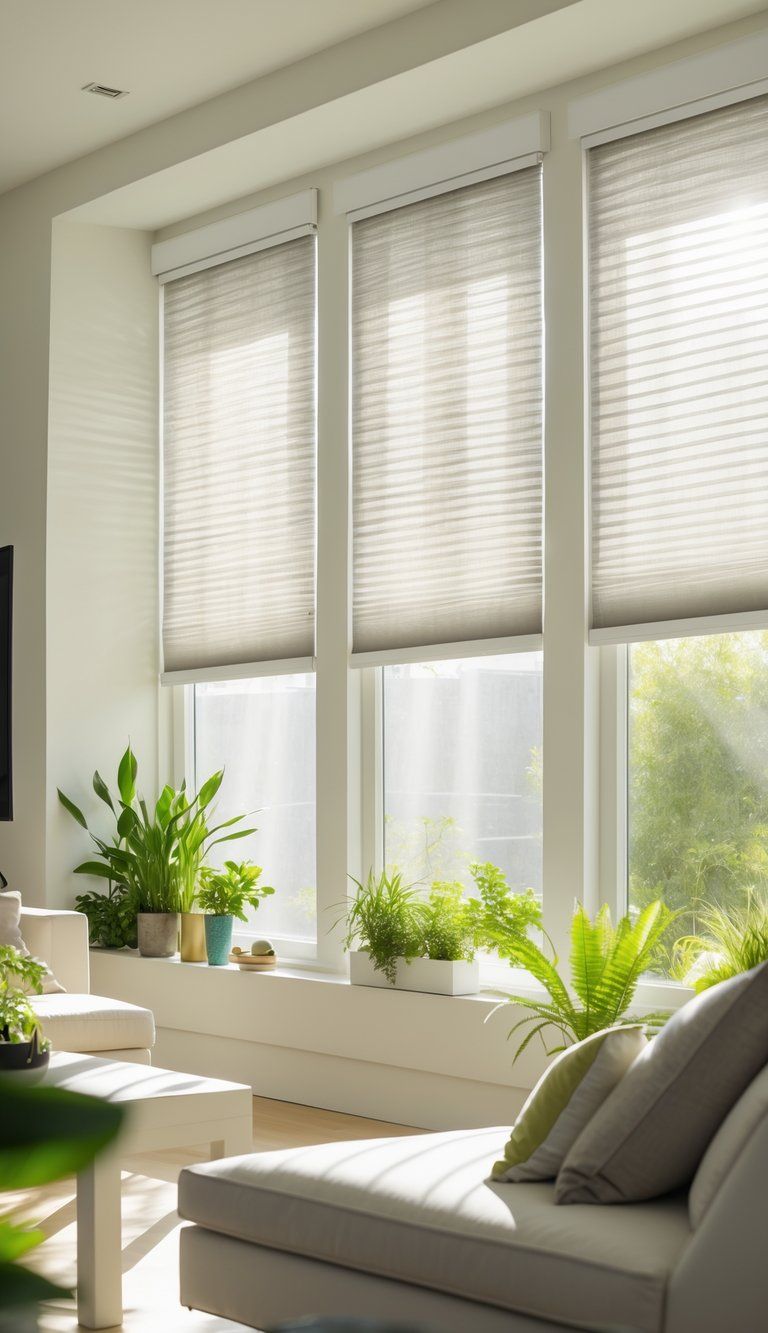
Window treatments can do more than just look good. They can lower your energy use and save you money. The right coverings act as barriers, keeping heat in during winter and out during summer.
Insulation and Temperature Regulation
Windows let a lot of energy escape—sometimes up to 30% of your heating and cooling. Good window treatments add an insulating layer to help keep temperatures steady inside.
Cellular (honeycomb) shades stand out for insulation. Their pockets trap air, making a buffer between your room and the window. In winter, they stop heat from leaking out. In summer, they block heat from coming in.
Insulated curtains and drapes with thermal linings also help regulate temperature. Floor-length styles that seal the window frame work best.
Plantation shutters give you another solid option, especially for sunny windows. You can tilt the louvers to control both light and heat.
Reducing Utility and Energy Bills
Energy-efficient window treatments can cut heat loss by up to 40% and reduce heat gain by up to 77%. That’s what the Department of Energy says, anyway.
Lower heat loss means lower bills. Most people see a 10-15% drop in heating and cooling costs after installing good window treatments. If you pay $200 a month for energy, that’s a yearly savings of $240-$360.
Try these for the best results:
- Window awnings: Slash solar heat gain by 65-77%
- Cellular shades: Cut heat transfer by up to 60%
- Reflective blinds: Reduce summer heat gain by 45%
If you live somewhere cold, focus on insulation. In warmer spots, go for solar heat reduction. Some options do both.
Maximizing Energy Savings
Want to get the most out of your window treatments?
- Layer smartly – Combine hard treatments like blinds with soft ones like curtains for extra insulation.
- Automate – Smart systems can open or close your coverings based on time, weather, or sunlight.
- Match the treatment to the window – South and west windows need more sun protection than north-facing ones.
Color and material matter too. Dark fabrics soak up heat, while light ones bounce it away. In winter, open south-facing coverings during the day for free warmth, then close them at night to keep heat in.
Mount your treatments close to the glass with minimal gaps. Floor-to-ceiling installations or side tracks help seal out drafts.
Remember to change things up with the seasons. Open coverings during sunny winter days, then close them at night.
Modern Innovations: Smart and Motorized Window Treatments
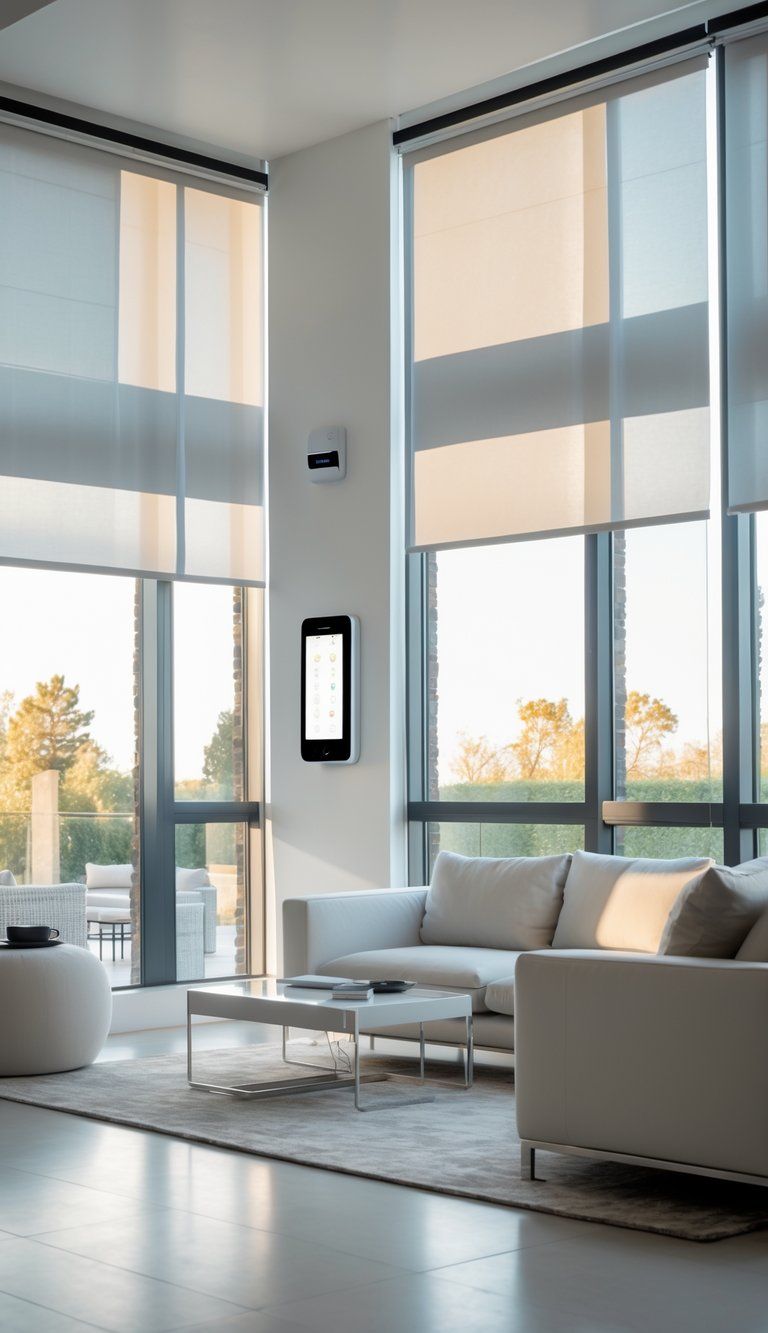
Window treatments aren’t just cords and rods anymore. Smart and motorized options make it easier to control light, boost energy efficiency, and keep your home safer.
Home Automation and Smart Home Integration
With smart window treatments, you can open or close your blinds on a schedule or with a quick voice command. Most systems work with Alexa, Google Home, or Apple HomeKit. Just ask, or tap your phone.
These systems do more than just add convenience. They can:
- Save energy by closing blinds automatically during hot afternoons
- Boost security by making it look like someone’s home
- Protect furniture by adjusting to the sun’s movement
Some motorized shades use sunlight or temperature sensors. You set it up once, and your home takes care of the rest.
Child Safety and Cordless Options
Cordless window treatments remove dangerous cords that can harm kids or pets. Motorized options go a step further—no manual controls at all.
The Consumer Product Safety Commission recommends cordless treatments for homes with children. Modern motorized blinds and shades meet these safety guidelines and add convenience.
What’s great about them?
- No cords or chains—much safer for kids and pets
- Sleek look—nothing hanging down
- Easier for people with mobility challenges
You can even get retrofit kits to motorize your current blinds. It’s way more affordable now than a few years ago. Smart window treatments are finally within reach for most homeowners.
Sustainability and Material Considerations
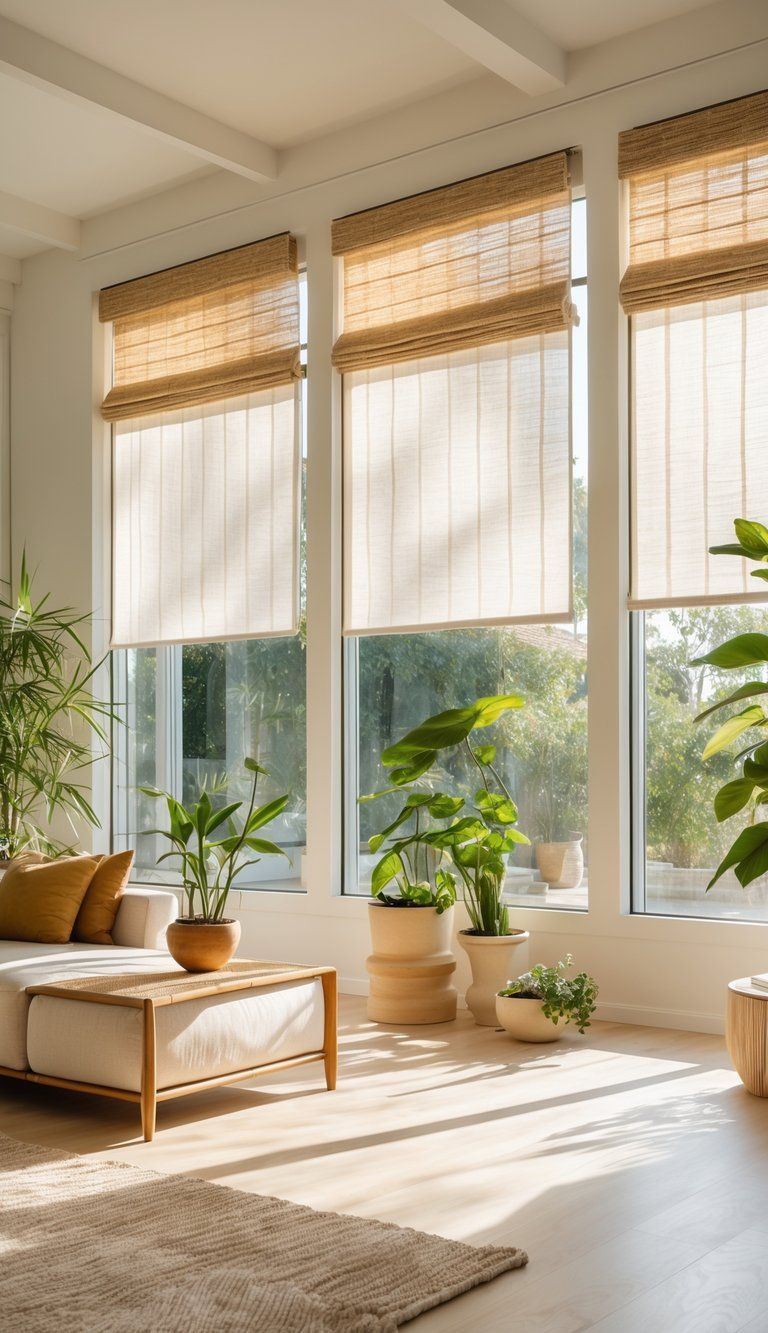
Picking eco-friendly window treatments helps the environment and your energy bills. Sustainable options can transform how your space feels while shrinking your carbon footprint.
Natural and Reclaimed Wood Options
Reclaimed wood shutters bring character and sustainability to your windows. They reuse old timber that might otherwise get tossed. Each shutter has its own unique grain and weathered look.
Woven wood shades made from bamboo, jute, or reed filter light beautifully. Bamboo grows fast and doesn’t need pesticides, so it’s a solid renewable choice. These shades create a warm, textured vibe as sunlight passes through.
Look for FSC-certified wood—this guarantees responsible forestry. Many brands now use non-toxic finishes and water-based stains.
Natural wood costs more upfront but usually lasts 15-20 years if you take care of it. That’s much longer than most synthetics.
Eco-Friendly Fabrics and Sustainable Materials
Hemp and organic cotton make great roller shades and curtains. They need less water and fewer chemicals to grow than regular cotton. If you pick natural dyes, you get beautiful light diffusion without harsh chemicals.
Recycled polyester, made from old plastic bottles, is another good option for durable window treatments. These fabrics:
- Cut down on landfill waste
- Use 30-50% less energy to produce compared to new polyester
- Block UV rays well
Cork is getting popular for cellular shades. It’s harvested without hurting trees and insulates naturally.
Look for GREENGUARD-certified treatments. They release fewer chemicals and help keep your indoor air cleaner while managing light effectively.
Professional Advice and Custom Solutions
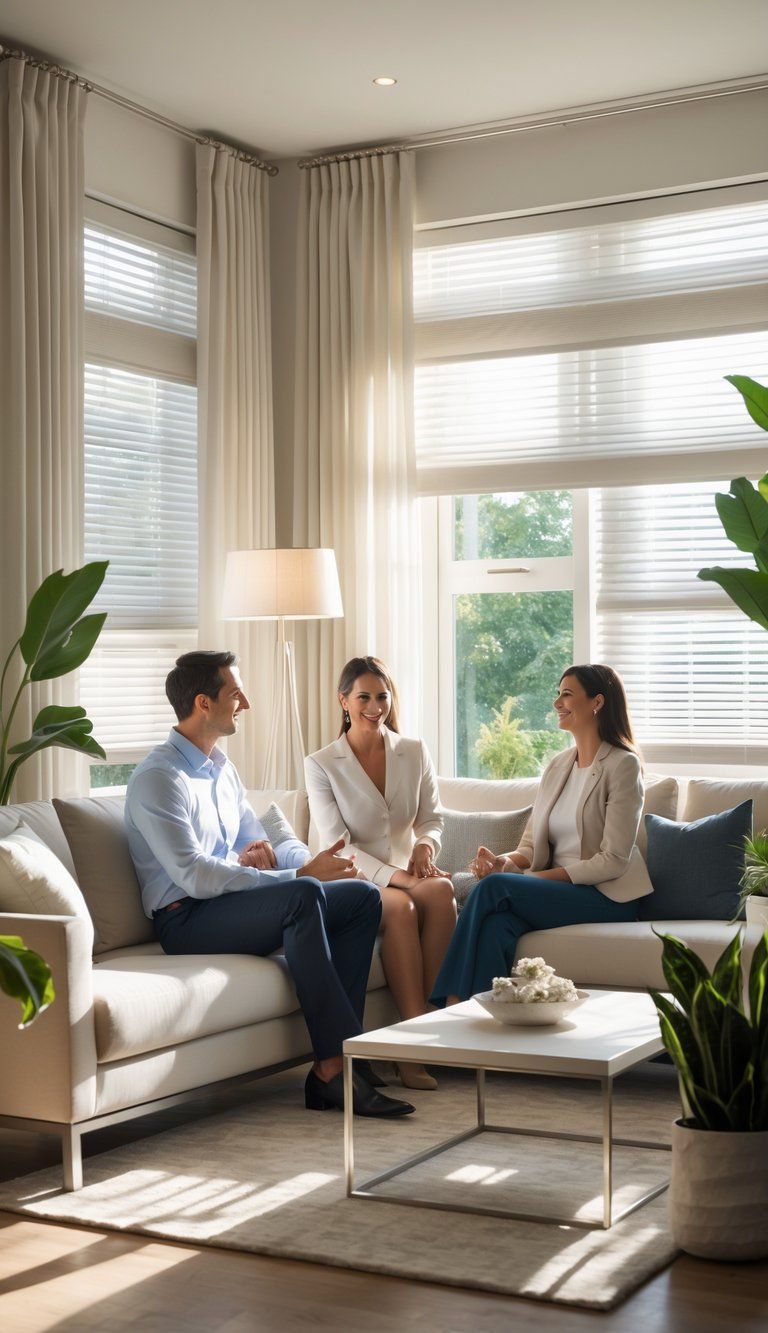
Getting help from experts can really change your window treatment experience. Designers know all about light control and can match solutions to your space.
Free Consultation Services
Lots of companies offer free consultations to help you choose. During these visits, experts will:
- Measure your windows
- Talk through your light and privacy needs
- Show you fabric and material samples right in your home
- Explain how each option changes your light
Professional Window Solutions LLC and others offer this service for free. Designers often spot tricky details, like unusual window shapes or tricky installations. This advice can save you time and help you avoid expensive mistakes.
Custom Window Shades and Blinds
Custom window treatments give you a perfect fit and all sorts of unique design choices. You just can’t get that with store-bought options.
When you go custom, you get shades and blinds made to your window’s exact measurements. You’ll also find a much wider variety of materials and colors.
Custom options let you match your home’s style, and honestly, those clean lines make a big difference.
Companies like iL Progetto focus on custom window treatments that really change the feel of a space. Their designers actually walk you through the choices, which helps if you’re not sure what you want.
Custom shades work especially well for odd-shaped windows or if you need a certain level of light filtering.
Balancing Aesthetics and Functionality
Nailing that sweet spot between style and function really makes window treatments work. Most designers pay attention to:
- How you want to control light—do you want to filter, block, or maybe redirect it?
- Your privacy needs, which can change as the day goes on.
- How much energy you might save with different choices.
- And of course, picking a style that actually fits your vibe.
Isabel, a designer with a knack for beach houses, shows that great window treatments should look amazing but also fix real-life issues. The right setup cuts down on screen glare or helps keep your furniture from fading in the sun.
When you work with professionals, they’ll break down what each material can do. Some fabrics block UV rays but still let you enjoy the view, while others give you crisp lines that really highlight your architecture.

